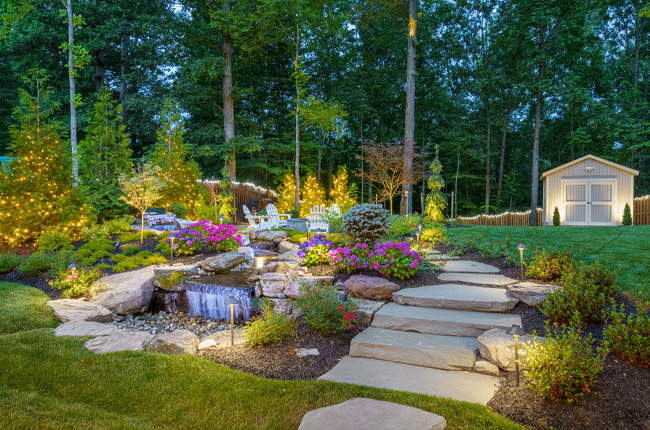Landscape design is much more than just putting in a few flowers or mowing the lawn; it is a blend of art and technique that transforms outdoor spaces into useful and visually appealing environments. Whether you are improving your home’s exterior appearance or creating a friendly atmosphere for your business, investing in expert landscaping can yield significant returns. This guide will help you explore the world of landscaping, presenting you to the many facets that play a crucial role in achieving a beautiful and lush outdoor space.
From understanding the advantages of employing a landscaping service to exploring the most frequent errors and how to prevent them, this ultimate guide covers everything you need to know. We will explore essential topics like lawn care and maintenance, garden design and plant selection, hardscaping, seasonal landscaping tips, and sustainable practices that make your yard not only attractive but also environmentally friendly. Whether you are a DIY enthusiast or thinking about hiring professional help, we have insights and tips that suit all skill levels. Come along as we explore how to enhance your outdoor spaces and design a landscape that you can be happy with.
The Benefits of Professional Landscaping
Investing in expert landscaping offers homeowners and businesses both aesthetic enhancements and substantial monetary benefits. An effectively designed landscape design can boost property value considerably, with studies showing that professional landscaping can add up to 15 percent to the overall worth of a home. This investment in external beauty not just lures potential buyers and can also create a sense of pride and satisfaction for existing owners.
Beyond increasing property value, engaging a landscaping service provides expertise that ensures both functionality and innovation in design. Expert landscapers possess knowledge of nearby weather patterns, soil types, and native plants, enabling them to create a landscape that prospers year-round. This level of expertise commonly results in landscapes that are both stunning while being sustainable and tailored to the specific needs of the environment, a factor that is crucial for longevity and maintenance.
Furthermore, expert landscaping frees up precious time for homeowners and business owners. The complexities involved in design, plant selection, and ongoing maintenance can be overwhelming and labor-intensive. By entrusting these responsibilities to capable landscapers, property owners can savor their outdoor space without stress, ensuring that every element from lawn care to hardscaping is managed efficiently and effectively.
Crucial Lawn Care Practices
Maintaining a healthy lawn demands ongoing care and effort. One of the critical crucial techniques is frequent cutting. Keeping your grass at the appropriate height not only improves its appearance but also promotes root growth and minimizes weeds. It's essential to mow with sharp blades to ensure clean cuts, which can help avoid diseases. A common recommendation is to not exceed more than 33% of the grass height at once, as this can weaken the plants.
Nutrition is another key aspect in lawn care. Using the right type of fertilizer, based on soil tests, helps in supplying the critical nutrients your lawn needs to succeed. The timing of applications is also crucial; usually, a early season application helps in recovery from the cold months, while fall fertilization gets the lawn for the impending cooler months. Frequently testing your soil can assist you in understand nutrient deficiencies and adjust your fertilization routine as needed.
Irrigating plays a significant role in keeping your lawn vibrant and thriving throughout the year. Proper watering practices, such as deep watering infrequently, encourage deep root systems that are more resilient against drought. It's best to water early as this reduces evaporation and allows the grass to take in moisture before the warmth of the day. Keeping track of rainfall and adjusting your watering timing can greatly impact in creating a lush landscape.
Sustainable Landscaping Solutions

Implementing sustainable landscaping practices is essential for creating a green outdoor environment while improving the beauty of your property. Choosing native plants is a particularly effective strategies; these species are adapted to the local climate and soil conditions, demanding fewer water and maintenance compared to exotic varieties. Native plants also promote biodiversity by providing habitats for local wildlife, such as pollinators and other beneficial insects, which adds to a healthier ecosystem.
Another key element of eco-friendly landscaping is the adoption of water-efficient practices, such as xeriscaping. This approach centers around creating landscapes that minimize water usage through the selection of drought-resistant plants and the careful placement of hardscaping features. Adding rain gardens and permeable paving can also help manage stormwater runoff, allowing water to infiltrate into the ground instead of contributing to erosion and pollution. Web Site diminish water consumption but also enhance the visual appeal of your yard.
Lastly, sustainable landscaping often features organic gardening techniques, such as composting and natural pest control. By using organic fertilizers and practicing integrated pest management, you can maintain a thriving landscape without depending on harsh chemicals. This not only benefits the well-being of your plants but also safeguards local waterways and wildlife from harmful runoff. Embracing these eco-friendly landscaping solutions ensures your outdoor space stays vibrant while reducing your overall environmental impact.
